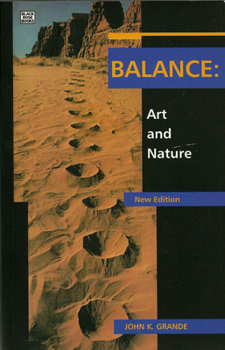Balance: Art & Nature Revised Edition
Nature is the art of which we are a part. Believing that artistic expression can and does play an important role in changing the way we perceive our relation to the world we live in, art critic John K. Grande takes an in-depth look at the work of some very unusual environmental artists in the United States, in Canada, and in Europe. Dealing with everything from materials, to the politics of curatorship, the permanence of art works, to the artist's role as cultural critic, Balance: Art and Nature takes theory into action as it critically examines the works of Anish Kapoor, Antony Gormley, Armand Vaillancourt, Bill Reid, Carl Beam, Kevin Kelly, Ana Mendieta, James Carl, Patrick Dougherty, Keith Haring, and others. What emerges is a viable social-environmental framework for evaluating contemporary art and insights into art's actual and potential roles.
Format:Paperback
Language:English
ISBN:1551642344
ISBN13:9781551642345
Release Date:November 2003
Publisher:Black Rose Books
Length:274 Pages
Weight:0.80 lbs.
Dimensions:0.7" x 5.6" x 8.3"
Customer Reviews
1 rating
Grande Brings Life and Nature to Today`s Art - Compass
Published by Thriftbooks.com User , 19 years ago
John K. Grande, Balance: Art and Nature. Montreal: Black Rose, 1994. 256 pages illustrated Review by Dennis Patrick O'Hara Not much is spared John K. Grande's sharp scrutiny as he critiques the state of western art in Balance: Art and Nature. Fortunately, the skill of his analysis is a match for the breadth of his critique. Grande contends that the egocentricity of modern western society and its infatuation with technology and consumerism have increasingly separated us from the natural world. That separation has an impact on the way our art is conceived, formed, marketed and even displayed. Grande proposes that art return to being more "ecocentric," reminding us that we are derivative and essentially dependent on natural processes. "In developing a nature-specific dialogue that is interactive, rooted in actual experience in a given place and time, and giving these elements an equal voice in the creative process," he writes, "we are ultimately respecting our integral connectedness to the environment." Holding such a vision, we will come to see that "nature is the art of which we are a part." To develop a dialogue more in touch with nature, Grande argues that artists should favour their specific culture and the diversity of the ecological communities in which they live rather than the homogenizing pressures of internationalism. He asserts that contemporary artists' preoccupation with international "market recognition," often reinforced by museums and funders, promotes a "product standardization" that takes precedence over any desire to represent one's own culture and bioregion. In such a horizontal milieu, artists and their works consequently become easily interchangeable. The attendant appropriation of Third World, tribal and extranational art styles not only mirrors acts of economic expropriation but also often ensures the commercial success of the collusive artists. Such appropriation barely pauses to appreciate the source culture's context and meaning. As an alternative, Grande proposes that we celebrate the cultural diversity naturally intrinsic to each ecological community or bioregion. Such a preference would nourish the artistic expression of the cultural symbolism and spiritual values unique to that region. It would enhance an intuitive dialogue with nature in the creation of art, encouraging a healthier relationship with the local environment. Grande vigorously argues and carefully develops his positions, drawing on a breadth of sources, ranging from Thomas Berry to Marilyn French, for support. Along the way, he censures many artists, institutions, art journals and both modern and postmodern ideologies, including Andy Warhol whose "art hides its terror of human communication behind commercial illustration" and such "bombastic promotional glossies" as Canadian Art magazine. Grande also describes the work of several artists who have already embraced the ecocentric art esthetics that he champions. Among these are Andy Goldsworthy, w





